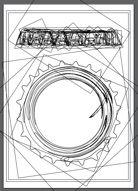Buy a print
BOTTLE TOP
This simple object, made strong by its complex shape, forms an airtight seal and withstands the pressure of carbonated drinks keeping them fresh, easy to transport and simple to store.
This has led to a vast worldwide market for soft drinks worth £530 billion in 2020 with the average Britain consuming some 211 litres per year.
However, soft drinks have been linked to obesity, kidney damage, heart desease and even cancer. The British Soft Drinks Association respond by saying that these drinks help prevent dehydration so stop headaches, help concentration and prevent joint pain. Sales are slowing due to competition from bottled waters. This has lead manufacturers to add vitamins and mineral to try to present an healthier image. However Helen Nestle from New York University says "We are not vitamin deficient, and these beverages do not address the real health issues‘.
The metal bottle top was invented by William Painter in 1892. Until then carbonated drinks bottles had round bottoms and were stored on their side to prevent the corks from drying out and letting the gas seep away.
The basic cap is formed from a coated steel blank which is pressed into a mould by a shaped former. Initially a paper layer was fitted inside the cap to prevent the liquid from making contact with the metal. Today this has been replaced with a plastic seal.
Sources:- Stastistica.com MSU.edu and Gizmodo.com, British Soft Drinks Association, Webmd.com and Wikipedia.
DRAWING
The form of the elevation [side view] is compact and complex which makes it challenging to observe and therefore to draw. The curved undercuts contrast with the bright ‘ridges’ and change as they catch the light, casting shadows in a variety of ways.
The base view shows a slightly concave inner circle of plastic coating, surrounded by raised rings and deep recesses enclosed within the serrated outer rim, the edge of which reflects varying amounts of light and creates deep shadows.

An image of the elements that were created to make the drawing













